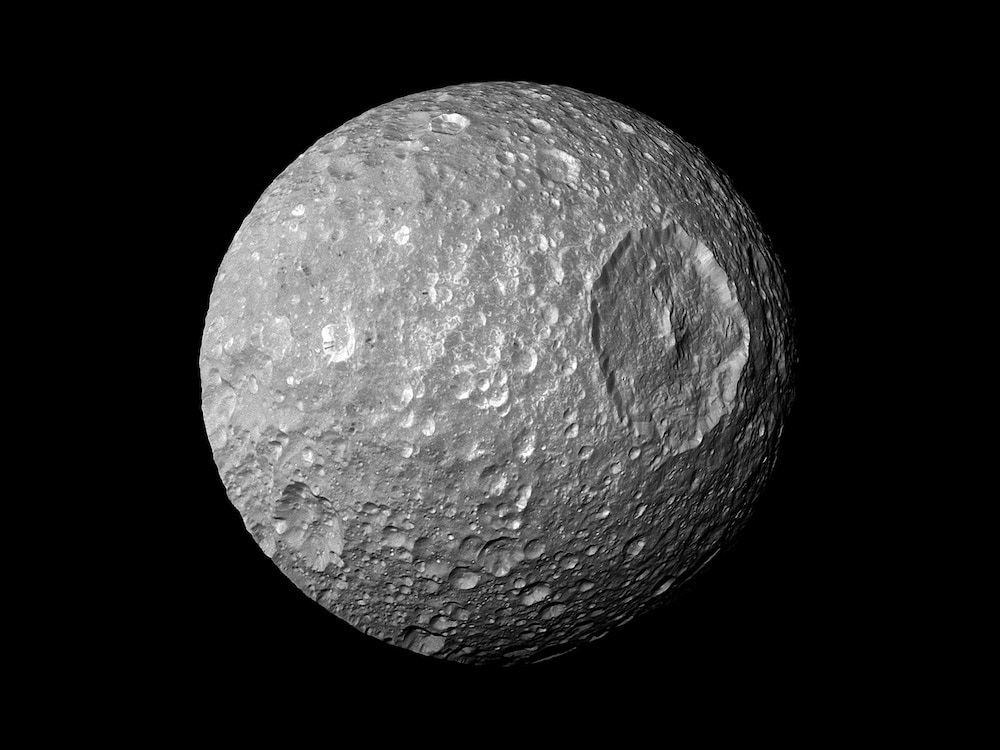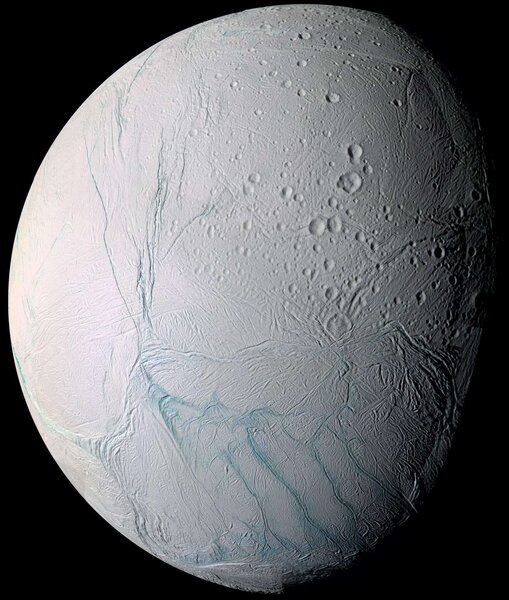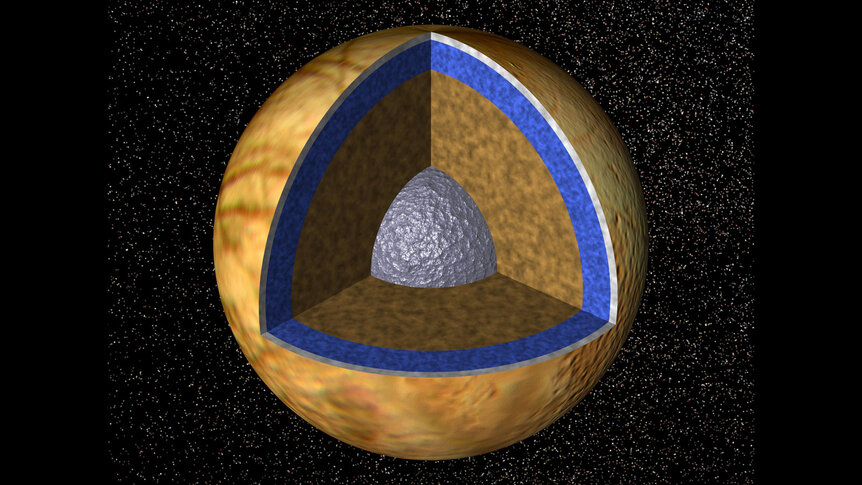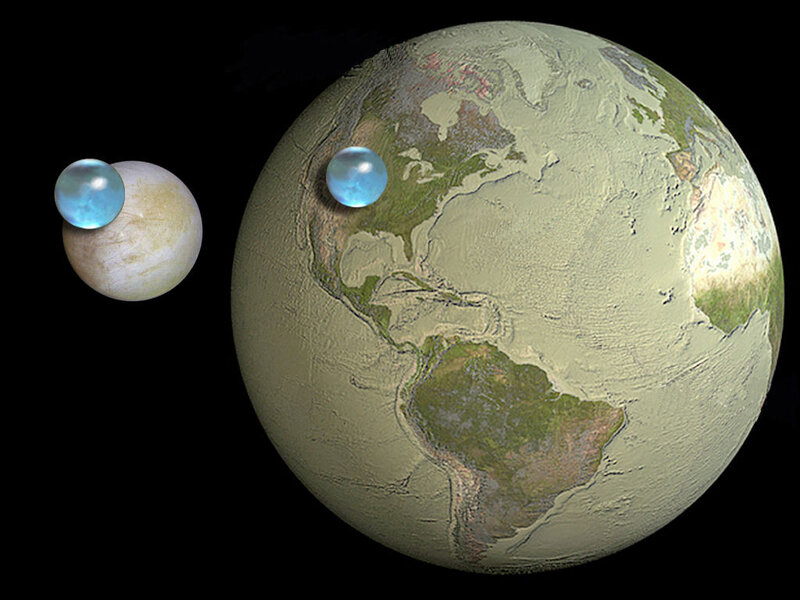Create a free profile to get unlimited access to exclusive videos, sweepstakes, and more!
Does Saturn's Death Star moon have an ocean under its surface?
Mimas is small, but may contain watery secrets.

Saturn is arguably the most beautiful planet in the solar system, and out of its fleet of many dozens of moons, Mimas is one of its coolest.
It's not terribly big, a slightly egg-shaped spheroid about 400 kilometers wide. The surface is heavily cratered, and in fact it's most famous for its ridiculously huge crater Herschel, which is 140 km across and gives Mimas the uncanny resemblance to the Death Star*.
It also has a very low density, indicating it is mostly water ice with very little rock. It orbits Saturn at a distance of about 186,000 km from the planet's center, just outside the main rings, and the orbit is almost but not quite a perfect circle: its distance from Saturn varies by about 4% over its 22.6-hour orbit, and that's very interesting indeed.
Why? Because Saturn's gravity is immense, and changes over that change in distance. This in turn imparts a tidal force on Mimas, squeezing and expanding it every orbit. That creates friction inside the moon, which heats it. It also orbits at a very slight angle to Saturn's equator, by about 1.5°, and that too means the way Saturn's gravity interacts with Mimas changes as it orbits.
We know that, for example, such tidal heating from Jupiter is enough to create volcanoes on its moon Io and an undersurface ocean on Europa. And Saturn's moon Enceladus also is heated enough by this effect to create an undersurface ocean on the small moon, which can actually force water out of cracks in the surface so hard it actually erupts in geysers!
So... does Mimas have an undersurface ocean as well?
This idea was proposed in 2014, and based on that a team of astronomers decided to look into it to see if it's plausible. In their new paper, they use physical models of Mimas to see if it might indeed have a liquid water ocean buried beneath its icy surface.
This is not a simple task. The amount of heat generated by tides is straightforward enough, but a more important question is how that heat affects the moon. For example, tides deform the shape of an object, and water flows more easily than solid ice — the Moon exerts tides on Earth, and this affects the oceans enough to create a rise and fall of the surface by several meters, but the solid Earth only deforms by a half meter or so. So, if the liquid water layer in Mimas is too thick then the tides will affect the moon more strongly. This should circularize its orbit rapidly, so the layer can't be too thick.
Also, unlike Enceladus and Europa, the surface of Mimas is covered in craters, which means the ice shell must be pretty thick, and the heat flowing out from the interior must be small, or else the surface would be warm enough to cause the craters to slump over time.
There's a lot more physics involved, including how the solid ice shell surface deforms, how much an interior ocean would heat the base of that ice shell, and what the surface temperature is. But in the end what they found is that using pretty reasonable assumptions it's certainly possible for Mimas to have an undersurface ocean. The ice shell would be from 24–31 km thick, and the ocean underneath it 39–26 km deep, covering a small rocky core with a radius of about 127 km.
That's a lot of water! About 10 million cubic kilometers or so. That's a small fraction of Earth's surface water (which totals about a billion cubic kilometers) but still a thousand times the amount of water in Lake Superior. Plenty of room to swim around in.
To be clear, this doesn't mean that ocean actually exists! It just means that the physics allows it, and it would explain the odd orbit of the moon and some of its behavior as it orbits Saturn.
The hard part is explaining how it would come to have such an internal liquid layer in the first place. Most formation mechanisms hypothesized for Mimas would either have it always be solid as it slowly grew from accumulated icy ring particles around Saturn, or have it get an ocean so large the tides would make the orbit a perfect circle, which we know not to be the case.
A further complication is the lack of cracks in its surface like Enceladus has. That comes from cooling of the moon over time, which puts a lot of strain on the ice and also thickens it — it freezes from the top down. So a lack of geologic activity and cracks in the surface imply the shell has not thickened over time. The problem is that over time tides push Mimas away from Saturn — its orbit gets larger, the same way the Moon is receding from Earth due to tides — which reduces the tidal stress and lowers the amount of heating, meaning the shell should get thicker. Paradox! It's possible the orbit gets more elliptical over time as it moves away from Saturn, which would add to the tidal heating, balancing the loss of heating as the orbit increases.
So while it's not clear how an ocean would form or be maintained, that doesn't mean it doesn't have one. The point is, it's possible.
And that's wild. If a moon as small as Mimas can have an undersurface ocean, how many other tiny worlds could have hidden oceans as well? There are a lot of wee icy moons orbiting the four outer giant planets. The amount of liquid water out there is certainly far more than exists on Earth's surface (Europa alone has more).
And we think that life needs liquid water to arise and evolve; while this is very speculative it's interesting to wonder how many chances for life are out there.
Our solar system is vast and plentiful with worlds, and we've only barely started to explore them. What awaits us when we finally dig into them more deeply, both figuratively and literally?
*Yes, yes, that's no moon, please, that joke has been made more than a few times before. I don't have to be force-sensitive to know that when this article goes live I will have to direct a lot of Twitter followers to this footnote.






























